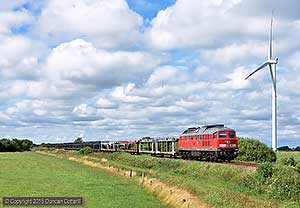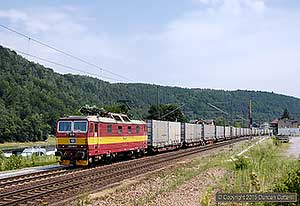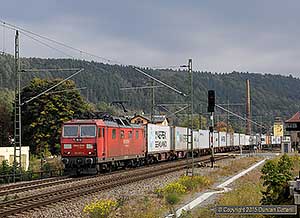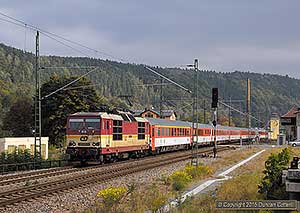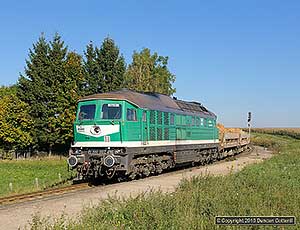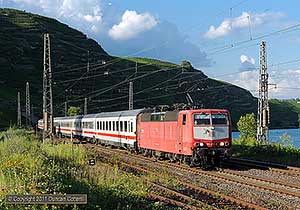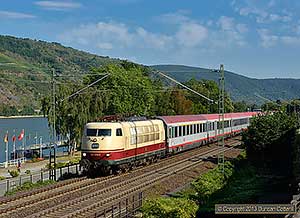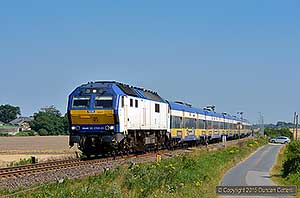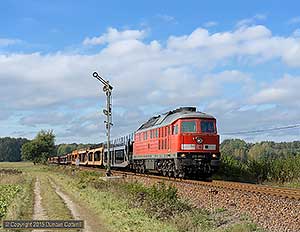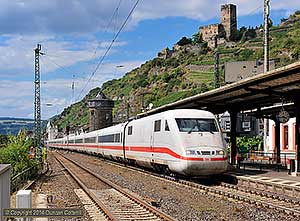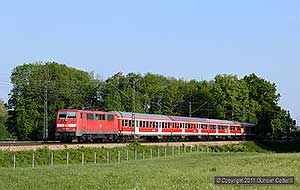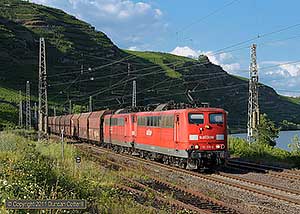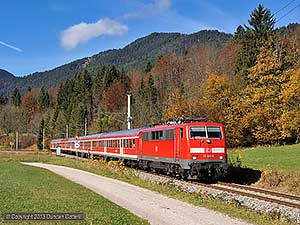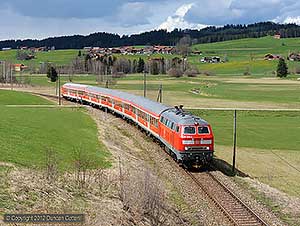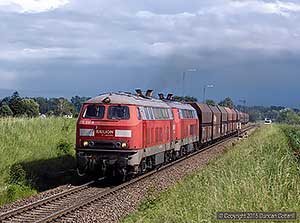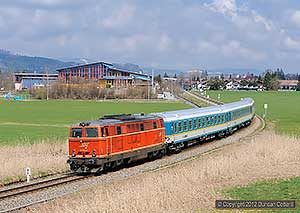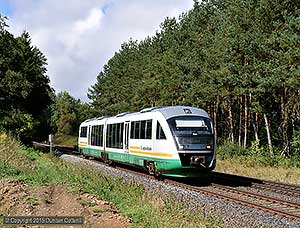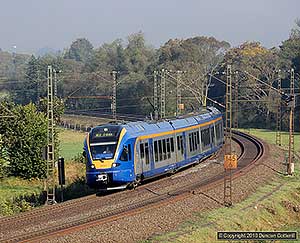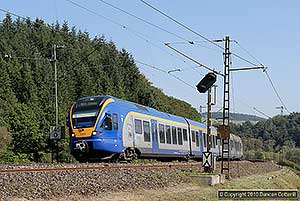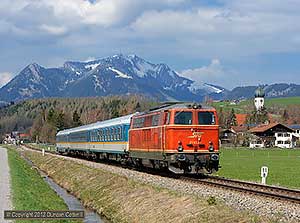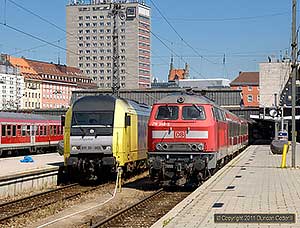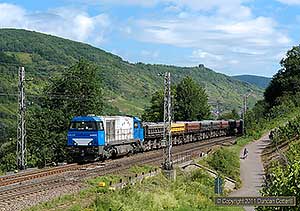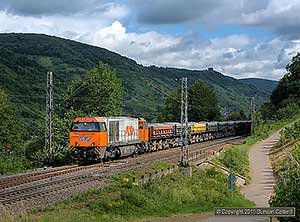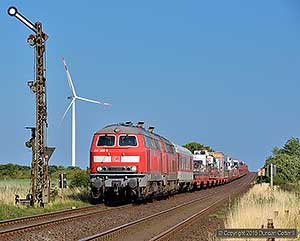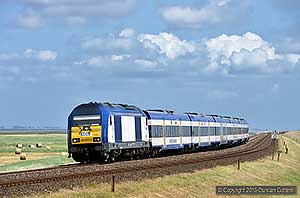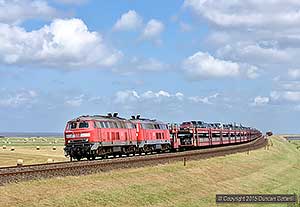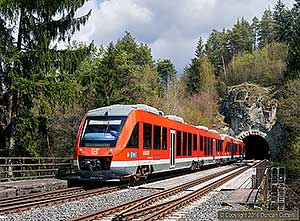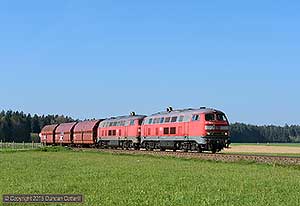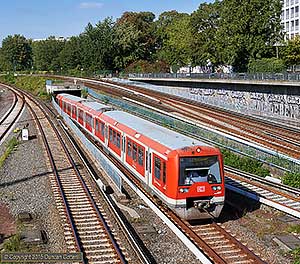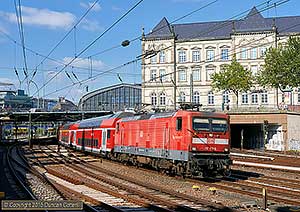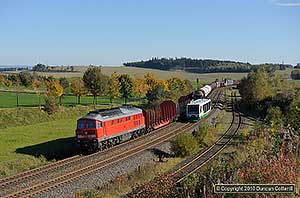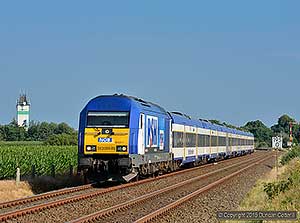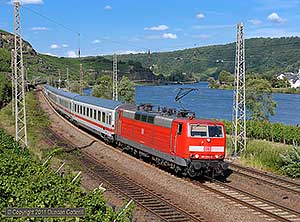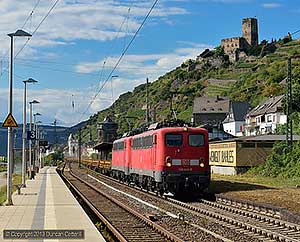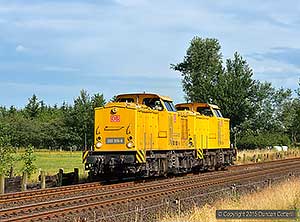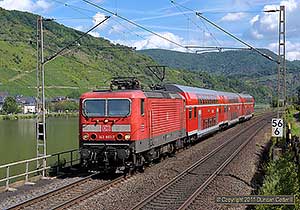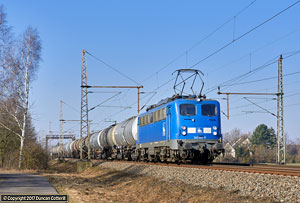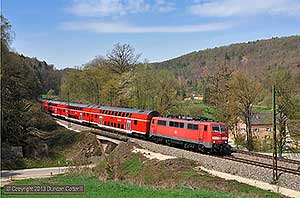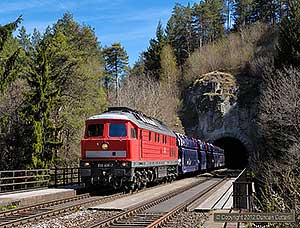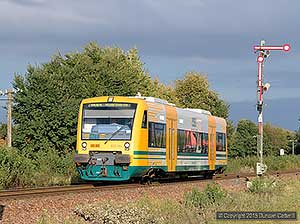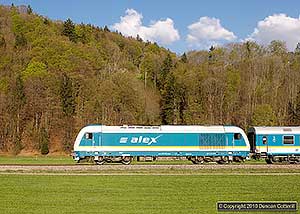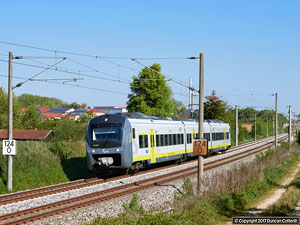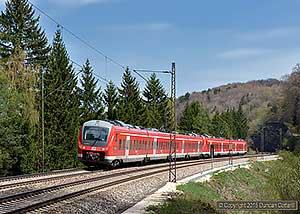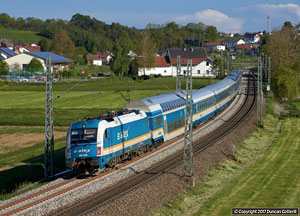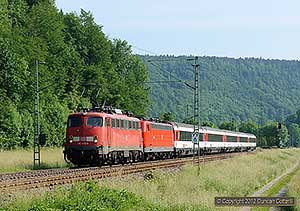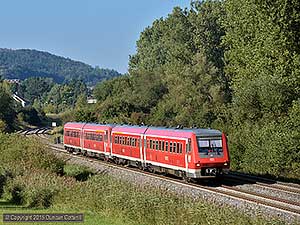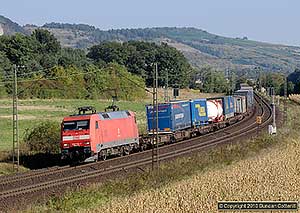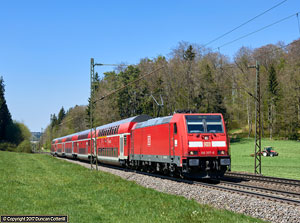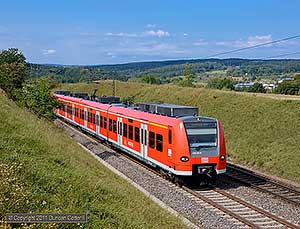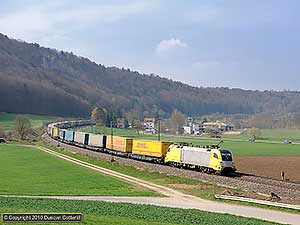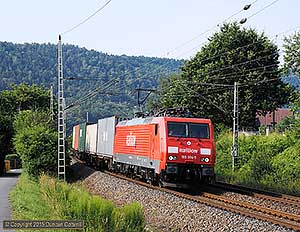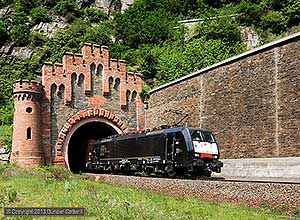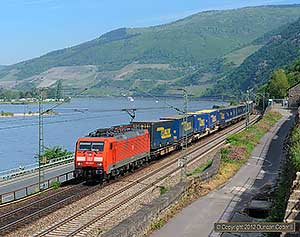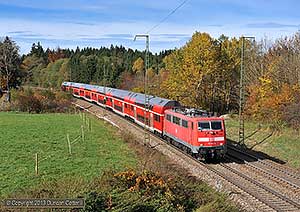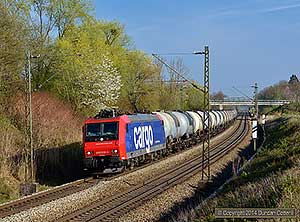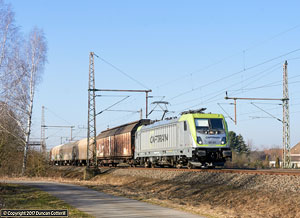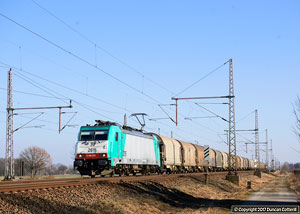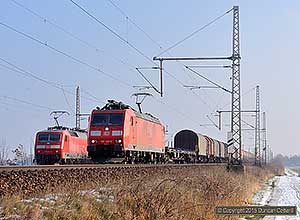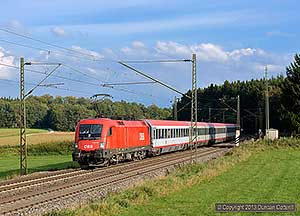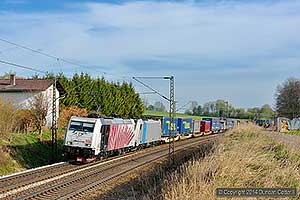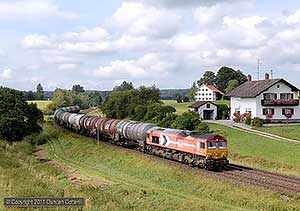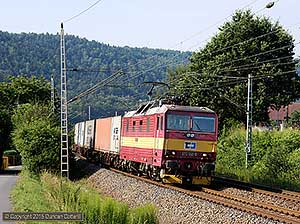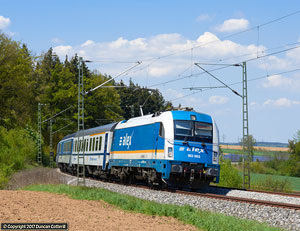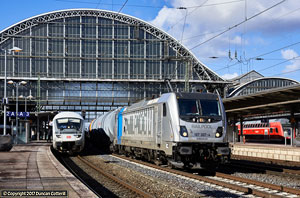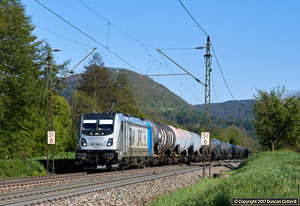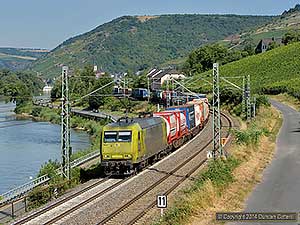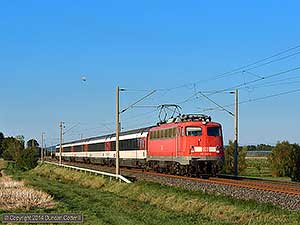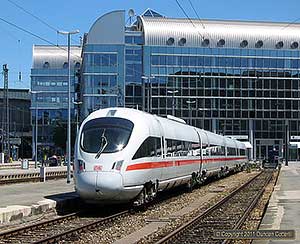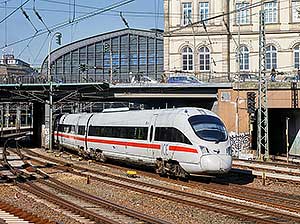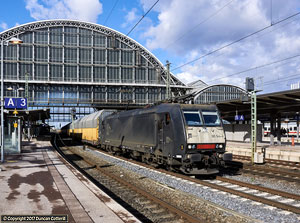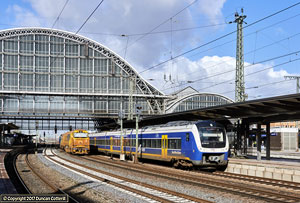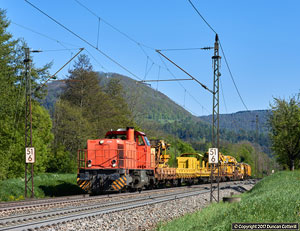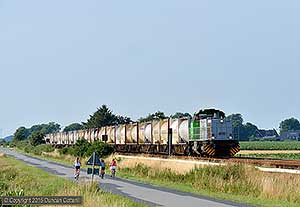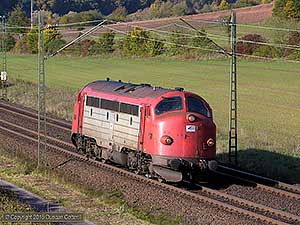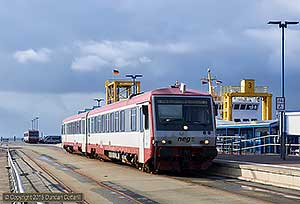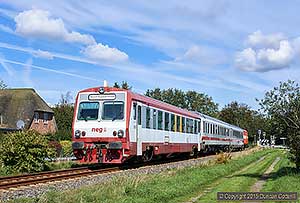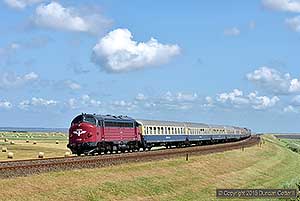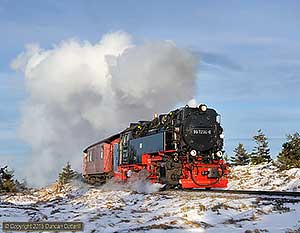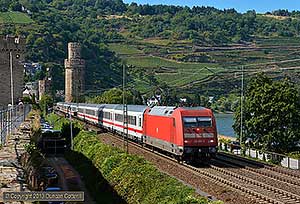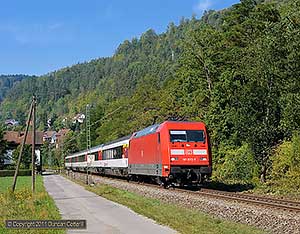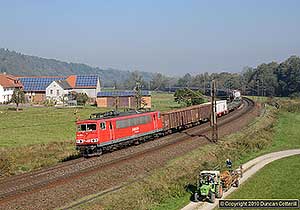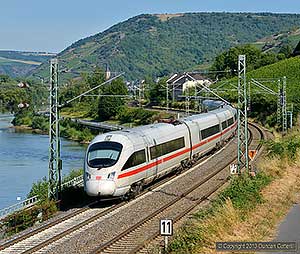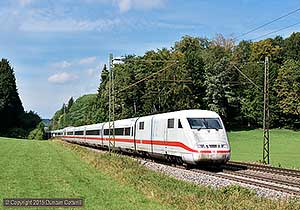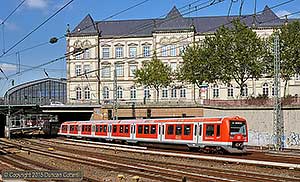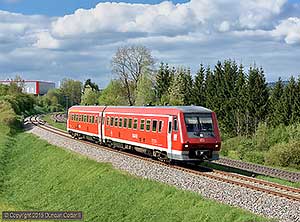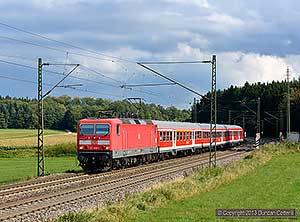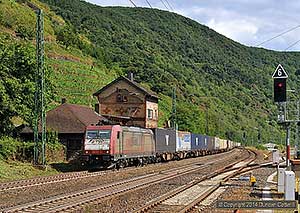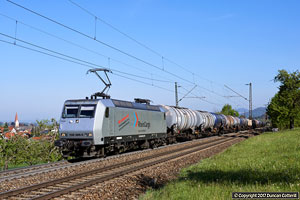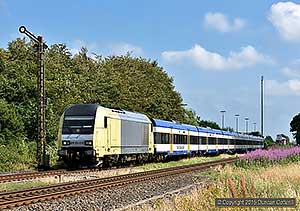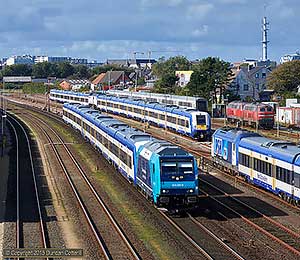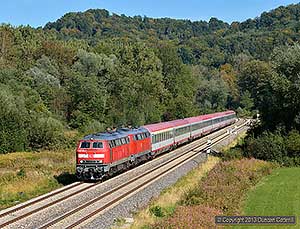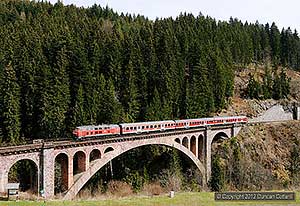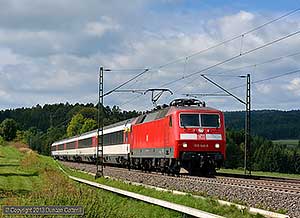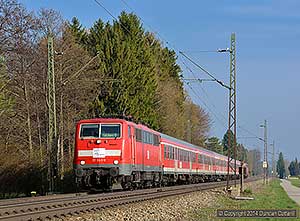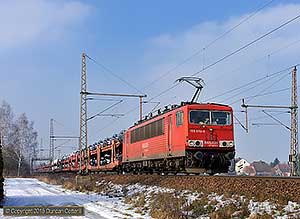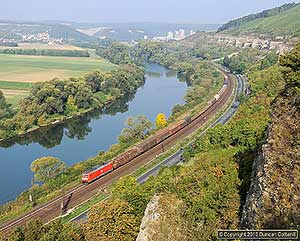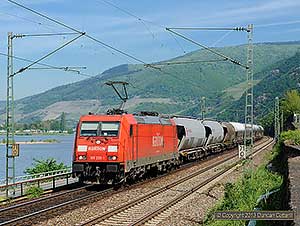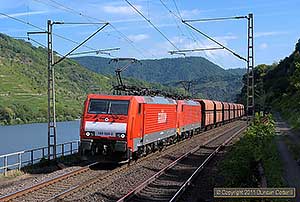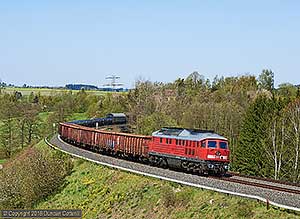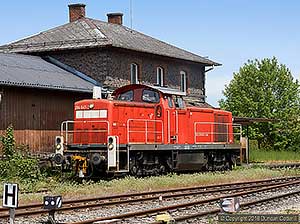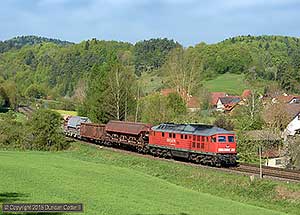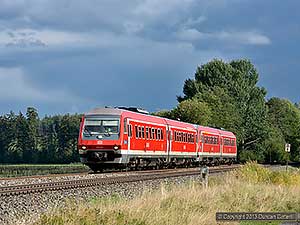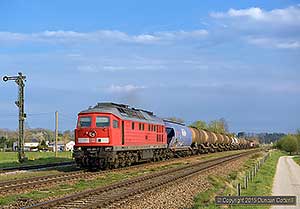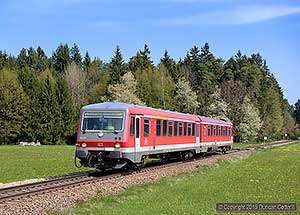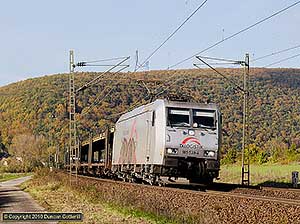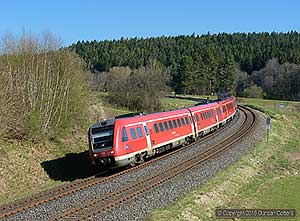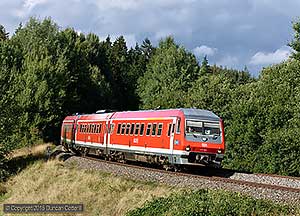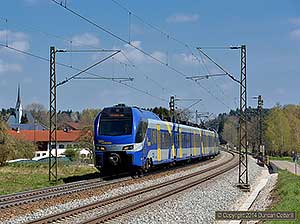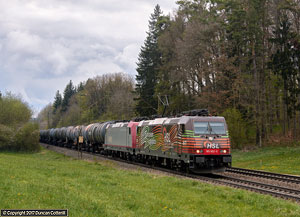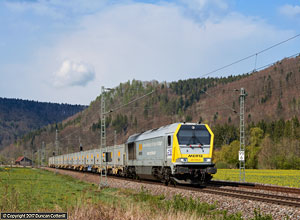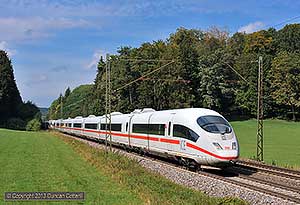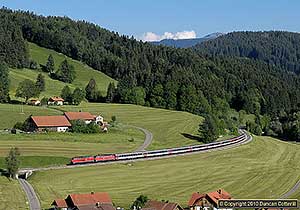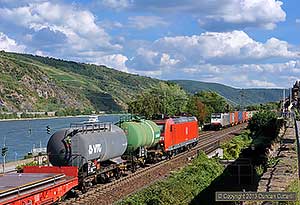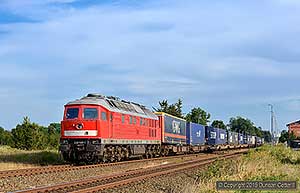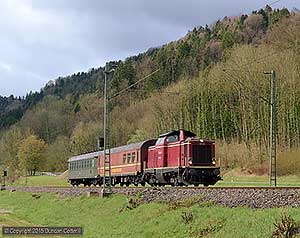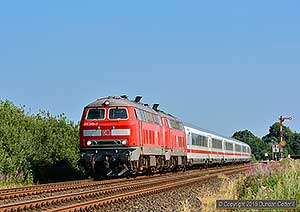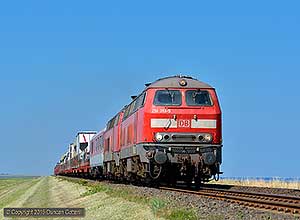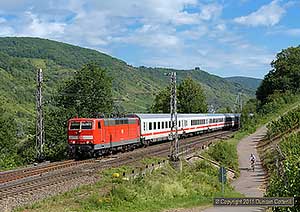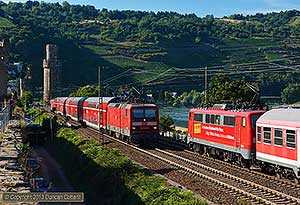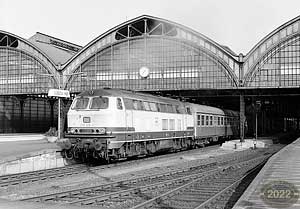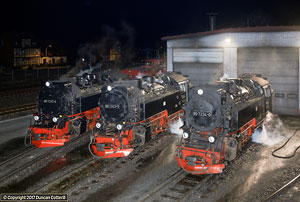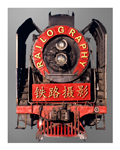136 Niebüll - Tønder
6 photos
updated : 2015-08-03
The Niebüll - Tønder line is normally a quiet backwater hosting the occasional cross-border DMU between Germany and Denmark but for two three week periods in the summers of 2014 and 2015 it was used as a diversionary route for international freights hauled by class 232 and 233 diesels.
Ceske Drahy
9 photos
updated : 2015-08-04
Czech Railways (ČD and ČD Cargo) locos have long worked EuroCity passengers and many freight trains along the Elbe Valley to Dresden and occasionally further into Germany. In the era of open access and standard loco types across Europe, they could appear anywhere in Germany in the future.
Class 180
11 photos
updated : 2015-08-04
DB's Class 180 and CD's Class 371 and 372 electrics are dual voltage 15kV AC/3kV DC versions of standard 1980s Skoda designs. Classes 372 and 180 are almost identical with class 371 being geared for higher speeds. DB have since withdrawn the class 180s but the CD locos remain in service.
241 Dresden - Schöna
20 photos
updated : 2015-08-04
This busy line runs up the scenic Elbe Valley from Dresden to the Czech border, north of Decin, and is part of a major north-south international route. At the time of my visits Czech locos were much in evidence on passengers and freight along with DB Class 143 electrics on local passengers.
Wismut Werkbahn
2 photos
updated : 2015-08-05
The Wismut Werkbahn was an industrial line that used to serve uranium mines around Ronneburg, near Gera. It now transports materials for the restoration of old mining sites. Motive power was provided by a fleet of V300 diesels, ex-DB class 232s rebuilt with Caterpillar engines and painted green.
Class 181
20 photos
updated : 2015-08-06
DB's dual voltage 15kV/25kV class 181s were built in the 1970s to operate cross- border services to Luxembourg and France. They still had a few international duties in the early 2010s but also visited other parts of Germany, including the Stuttgart - Singen line. All have now been withdrawn.
Class 103
5 photos
updated : 2015-08-31
DB's Class 103s were fast and powerful. They powered the InterCity revolution of the '70s and '80s but were becoming expensive to operate by the late '90s. All were withdrawn by late 2002. Remarkably, four returned to front line use in 2013 when problems with ICE sets caused a locomotive shortage.
Class 251
8 photos
updated : 2015-10-26
Twelve powerful Co-Co diesel electrics were built by MaK for Norway in the mid 1990s but were plagued with faults and rejected by NSB. Back in Germany they were extensively rebuilt and several worked for years on NOB (Nord-Ostsee Bahn) Marschbahn passenger services between Hamburg and Westerland.
229 Hoyerswerda - Horka
4 photos
updated : 2015-10-30
The Hoyerswerda - Horka line was a classic rural railway in 2010; single track with passing loops, semaphore signals, telegraph poles, a sparse passenger service and a handful of diesel hauled freights. It closed shortly afterwards for conversion into a double track, electric freight corridor, reopening in 2018.
Class 401, 402
7 photos
updated : 2015-10-30
Class 401 units were introduced in 1989 and were the original ICE high speed EMUs, capable of 280km/h and usually formed of two power cars and 12 trailers. Class 402 followed a few years later with a single power car, 6 trailers and a driving trailer. Both classes are still in front-line service.
880 Nürnberg - Passau
7 photos
updated : 2016-01-21
The Nürnberg - Passau line is a busy, double-track electrified railway and part of the primary route linking northern Germany with central and eastern Austria. It's not a particularly scenic line but it does see fairly heavy freight traffic as well as regional and long distance passenger trains.
Class 151
14 photos
updated : 2016-01-21
Class 151 was DBs standard heavy freight locomotive until the end of the 1990s. Introduced in 1973, the 151 was the first German class with thyristor control and with a 6400kW/8500HP rating it was a formidable machine. DB sold its remaining 151s to Railpool in 2017 and around 50 are still in use.
960 München - Mittenwald
6 photos
updated : 2016-01-21
The Mittenwaldbahn is a scenic single-track line from München to Mittenwald, on the Austrian border. Passenger services were worked by class 111 electrics for many years until EMUs replaced them at the end of 2013. These photos date from October 2013 when the 111s were still in charge.
974 Biessenhofen - Füssen
6 photos
updated : 2016-01-22
The König Ludwig Bahn is a 30km line running south from Biessenhofen on the Allgäubahn to Füssen, a picturesque town on the Austrian border, famous for it's castles and mediaeval buildings. This is a passenger route where most trains used to be worked by class 218s on push-pull sets but are now all units.
Class 215, 225
18 photos
updated : 2016-01-22
DB's Class 215 was an intermediate design, essentially a class 216 in the body of a class 218. Introduced in 1968, 150 of these medium-power diesel-hydraulic B-Bs were built and saw use on passenger and freight duties for many years. Class 225 comprised Class 215 (and a few 218s) for freight use.
ÖBB Class 2143
10 photos
updated : 2016-01-27
The ÖBB Class 2143 and similar Class 2043 were the standard Austrian main line diesels of the 1960s and 1970s. A number were sold to independent operators including 3 to Augsburg based SVG. The SVG engines were hired by ALEX for the Oberstdorf - Immenstadt shuttles on a number of occasions.
Vogtlandbahn
5 photos
updated : 2016-01-27
The Vogtlandbahn started running local passenger services in the Vogtland area of Sachsen in 1994 and has expanded into neighbouring Thüringen and Bayern and runs across the border into the Czech Republic. All services are operated by DMUs. Vogtlandbahn is now owned by Netinera.
Class 426 - 430
6 photos
updated : 2016-01-27
Classes 427 to 430 are the three to six car versions, respectively, of the Stadler Flirt articulated EMU design and have proven popular in Germany with over 450 units in service with DB and independent regional operators. More Flirts are on order for Germany, including a battery-electric version.
Cantus
4 photos
updated : 2022-08-29
Cantus is a joint venture between the Hamburger Hochbahn and Hessische Landesbahn and has had the contract to operate local passenger services around Kassel since the end of 2006. It uses 3-car Class 427 and 4-car Class 428 Stadler Flirt articulated EMUs on all its routes, including the line south to Fulda.
SVG
11 photos
updated : 2016-01-27
SVG started as a preservation operation based on the Staudenbahn, a closed line near Augsburg, but has expanded into the loco hire business. SVG's ex ÖBB Class 2143 diesels have been used on ALEX passenger services. They also had 3 ex ÖBB Class 1142 electrics at one time.
999 München Area
16 photos
updated : 2016-01-27
München is Germany’s third largest city and one of the country's principal railway hubs. The Hbf sees plenty of regional, InterCity and international passenger services. A variety of diesel and electric locomotives are regular visitors to the station including those of independent operators and ÖBB.
Class 272, 273
5 photos
updated : 2016-01-27
Vossloh's G2000 is a compact high power B-B diesel-hydraulic introduced in 2000 and classed as 272 or 273 in Germany. The 273s have an unusual asymmetric cab. The G2000 hasn't proven very popular with operators, with less than 70 locomotives sold to freight operators and infrastructure companies.
RTS
4 photos
updated : 2016-01-27
RTS Rail Transport Service is a subsidiary of Swietelsky, a large Austrian civil engineering contractor with a presence in many European countries. RTS's main activities are centred around moving track machines and running engineering trains but it also contracts for freight work.
Class 642
5 photos
updated : 2016-01-27
The class 642 is a lightweight articulated 2-car DMU from the Siemens Desiro range. DB have over 230 and they're also popular with independent operators. Although designed for lightly trafficked branch lines, they seem equally at home on main line stopping services and can be found in many parts of Germany.
130 Hamburg - Westerland
144 photos
updated : 2016-06-02
The Hamburg - Westerland line is also known as the Marschbahn and runs through the low-lying flat countryside of Schleswig-Holstein. It's a very traditional railway in many ways with loco hauled trains and semaphore signals and hosts an unusual car-carrying operation between Niebüll and the island of Sylt.
Nord-Ostsee Bahn
35 photos
updated : 2016-06-02
The Nord-Ostsee Bahn or NOB operated regional passenger services between Hamburg and Westerland from 2000 to 2016. NOB had a fleet of Class 223 and Class 251 diesels and modern push-pull stock. It also had a few DMUs for local services but the vast majority of trains were loco hauled.
Sylt Shuttle
48 photos
updated : 2016-06-02
The Sylt Shuttle is a DB Autozug car carrying operation linking the island of Sylt with Niebüll on the mainland. It's a bit like the Channel Tunnel but with no tunnel and diesel haulage. Trains run as frequently as half hourly, carrying all types of road vehicle from articulated lorries to cars and motorbikes.
Class 648
6 photos
updated : 2016-06-02
The class 648 is a lightweight articulated 2-car unit, designed by Linke-Hofmann-Busch but now built by Alsthom as the Coradia LINT 41. Class 648 DMUs are in widespread use with DB and independent operators and can be found in many parts of Germany on branch line and main line stopping services.
Class 217
16 photos
updated : 2016-07-05
Class 217 was introduced in 1965 and was a development of the class 216 with a separate diesel generator to provide electric train heating. A total of 15 were built and despite having ETH, they spent most of their lives working freight trains, latterly around Mühldorf. The last 217 was withdrawn in December 2011.
Class 472, 474
6 photos
updated : 2016-07-05
Hamburg's S-Bahn is a bit more interesting than most as it's electrified at 1200V DC with bottom-contact third-rail. The system has its own dedicated fleet of 3-car EMUs of different designs to the usual S-Bahn fare. In 2015 Class 474s operated most services but the older Class 472s were still quite common.
101 Hamburg Area
9 photos
updated : 2016-07-05
Hamburg is Germany's second largest city, a major seaport and one of the country's main rail centres. It has a busy S-Bahn, loco-hauled regional passengers in all directions, InterCity and ICE services to many destinations and lots of freight. This gallery barely scrapes the surface.
544 Reichenbach - Hof
24 photos
updated : 2017-03-10
This double track, main line is one of Germany's oldest, dating from the 1840s. It runs through the attractive Vogtland landscape, winding around rolling hills and crossing a couple of spectacular viaducts. The line was diesel worked at the time of my first visit in 2010 but has since been electrified.
Class 223, 253
156 photos
updated : 2017-03-10
The Siemens ER20 EuroRunner 2700hp Bo-Bo diesel is best known as the ÖBB class 2016 but many work in Germany, where they were originally Class 253, and now Class 223. They are popular with independent operators and can be found on some contracted passenger services as well as freight work.
690 Koblenz - Trier
40 photos
updated : 2017-03-10
The electrified double-track main line through the Mosel Valley is busy, scenic and relatively easy to reach from the UK. Around 2010 it was also home to the increasingly rare class 181 electrics and saw a good variety of locos from DB and other operators on frequent passenger and freight trains.
Class 139, 140
6 photos
updated : 2017-03-10
Class 140 and the similar class 139 were West Germany's standard 15kV AC Bo-Bo freight electrics from the late 1950s to the late 1990s. They can be considered the freight equivalent of the Class 110s. DB withdrew its last locos in 2016 but a number are still at work for the independent sector.
Class 201 - 204, 293, 298
8 photos
updated : 2017-03-10
Class 201 was the original DR V100 dating from 1966 while classes 202 to 204, 293 and 298 are all variations and rebuilds. In total over 1000 were built for DR, industrial users and export. DB retain a number for departmental duties while independents and infrastructure companies use many more.
Class 143
29 photos
updated : 2017-03-10
DB inherited over 600 of these 1980s built medium power Bo-Bo electrics from DR at reunification and soon put them to work on regional passenger services all over Germany. After several decades of service, the class is now being withdrawn and replaced by new EMUs but a number remain in service in 2022.
Press
5 photos
updated : 2017-03-10
Press is an offshoot of the preserved Pressnitztalbahn, a 760mm gauge line. Press owns, operates and hires out an interesting fleet of standard gauge diesels and electrics including some vintage machines. Most of its locos are painted in a very attractive blue livery but carry misleading numbers.
910 Augsburg - Nürnberg
9 photos
updated : 2017-03-15
The Augsburg - Nürnberg line is an important electrified, double track link between southern and northern Bavaria and is busy with a variety of traffic including long-distance and regional passengers and freights. The line is quite scenic in places, particularly around Treuchtlingen.
Class 112, 114
3 photos
updated : 2017-03-15
The Class 112 Bo-Bo electrics were introduced in 1990 as a faster version of the Class 143, geared for 160km/h. In total 39 Class 112.0 and 90 improved Class 112.1 were built. The Class 112.0 were later renumbered to Class 114. The survivors of both classes are used on regional passenger services.
860 Nürnberg - Hof / Cheb
62 photos
updated : 2017-03-16
Nürnberg - Hof is a diesel worked route running through attractive hilly country north and east of Nürnberg to the borders of the Czech Republic and the former DDR. Passenger services are worked by DMUs but there are also a number of freights hauled by ex-DR class 232 locos.
Class 650
9 photos
updated : 2017-03-16
The Class 650 single unit was introduced in 1996 and produced by ADtranz at the former DWM plant in Berlin. In 2001 the factory was sold to Stadler and production continued under their auspices. The 650s are popular in Germany, with DB and the independent sector operating over 450 units.
ALEX
145 photos
updated : 2017-03-16
ALEX operated loco hauled fast trains from München to Oberstdorf from 2002. From late 2007 München - Lindau and München - Hof services were added and, from 2010, some services to Plzen. The München to Lindau and Oberstdorf trains ceased in late 2020 but the Hof and Plzen trains still run.
Agilis
4 photos
updated : 2017-03-16
Agilis, a subsidiary of Hamburg based Benex, operates local passenger services on a number of lines in north-east Bayern, using Class 440 EMUs on lines radiating from Regensburg and Class 650 DMUs on the diesel worked routes around Hof, Marktredwitz and Bayreuth.
Class 440
7 photos
updated : 2017-03-16
Alstom's Coradia Continental articulated EMUs are Class 440 in the German numbering system and operated by DB and a number of independents including NordWestBahn and Agilis. The first 440s were built in 2008 and 3, 4 and 5 car sets have been produced to date at Alstom's Salzgitter plant.
930 Landshut - Regensburg
11 photos
updated : 2017-03-16
The Landshut - Regensburg route is fairly unremarkable, running through some of the flatter parts of Bayern. There are a few nice spots but it was the ALEX Class 183s, only used between München and Regensburg, that made it worth a visit. There were also DB Class 111s on REs and some freight as well.
740 Stuttgart - Singen
102 photos
updated : 2017-05-28
This single-track, electrified route runs along Neckartal on the east side of the Black Forest and carries local, semi-fast and international passengers as well as a few freights. The line has seen a wide variety of loco classes over the last few years, including classes 110, 111, 120 and 181, all living on borrowed time.
Class 611
8 photos
updated : 2017-05-28
DB's 2-car class 611 tilting DMUs were meant to be an all-German equivalent of the Class 610 units. Introduced in 1996, they had numerous problems and were withdrawn in 2018. All 50 sets were based at Ulm and used on RE and RB services on non-electrified routes in Baden-Württemberg.
Class 152
16 photos
updated : 2017-05-28
Class 152 was Siemens' answer to DB's requirement for a modern powerful 15kV AC freight loco and 170 were built between 1997 and 2001, based on the company's EuroSprinter prototypes. The locos are 8600hp Bo-Bos of Siemens type ES64F can be seen on electrified main lines all over Germany.
Class 146
25 photos
updated : 2017-05-28
Class 146 is the 15kV AC passenger version of the Bombardier Traxx 7500hp Bo-Bo electric locomotive fitted with bogies suitable for a maximum speed of 160km/h. DB have around 170 in use on InterCity and longer distance regional services across Germany, usually found coupled to double-deck push-pull sets.
Class 424, 425, 426
10 photos
updated : 2017-05-28
The 4-car Class 424 and 425 and 2-car Class 426 15kV AC articulated EMUs were introduced by DB in 1998-9 for regional services and can be found in many parts of Germany. Class 424 are identical to Class 425 apart from having retractable steps for use at stations with lower platforms.
990 Ingolstadt - Treuchtlingen
26 photos
updated : 2017-05-29
The Ingolstadt - Treuchtlingen line runs through Altmühltal, a beautiful winding valley cut into the limestone hills of Oberbayern. The line is no longer used by express passenger trains but now serves as the principal freight route from München to northern Germany and had a loco hauled local passenger service.
Class 189
14 photos
updated : 2017-05-29
Class 189 is a development of the Siemens Class 152 equipped to operate under all four major electrification systems, 1500V DC, 3000V DC, 15kV AC and 25kV AC, allowing operation in countries the Class 185 can't reach. DB has a fleet of 90 locos and others are in service with the independent sector.
MRCE Dispolok
51 photos
updated : 2017-05-29
MRCE Dispolok is one of Europe's largest locomotive hire companies with a fleet of over 130 modern diesel and electric locomotives, most of them registered in Germany. Dispoloks can be seen all over Germany on freights and on a number of passenger services operated by DB and independents.
466 Koblenz - Wiesbaden
36 photos
updated : 2017-05-29
The line from Koblenz to Wiesbaden along the right/east bank of the Rhein (Rechte Rheinstrecke) is one of Germany's busiest freight arteries and very scenic as well. Most of DB's freight electrics can be seen along with the locos of numerous independents and, occasionally, diverted ICs and ICEs.
950 München - Salzburg / Kufstein
32 photos
updated : 2017-05-29
The line from München to Salzburg and Küfstein is a busy, electrified, double track, international route carrying a wide variety of passenger and freight trains including Austrian Korridorzüge. The landscape is pleasant rather than spectacular but there are plenty of good photo positions.
SBB Cargo
6 photos
updated : 2017-05-29
SBB Cargo is the freight arm of the Swiss national operator and operates in Germany as SBB Cargo Deutschland. A number of SBB Cargo electrics are also hired to German independent operators and can appear almost anywhere. Class 482 electrics are the most visible type although class 421 also appear.
Captrain Deutschland
6 photos
updated : 2017-05-29
Captrain started life as Rail4Chem, an independent operator set up by and for the chemical industry in 2000. R4C was bought by Veolia in 2008 and in 2009 passed to SNCF and was grouped with its other German operations as Captrain Deutschland. This gallery includes predecessors, R4C and ITL.
Class 186
7 photos
updated : 2017-05-29
Class 186 is the multi-system variant of the Bombardier TRAXX family, differing from the class 185 by being equipped to operate from 3000V DC and in most cases also 1500V DC overhead. These locos are popular with the independent sector, particularly operators running trains between Germany and Italy.
360 Hannover Area
31 photos
updated : 2017-05-29
Hannover is an important city in northern Germany with its own suburban system. It's a major railway centre where routes from all directions converge, most with heavy passenger and freight traffic. What the area lacks in scenery, it makes up for with the quantity and variety of motive power on view.
ÖBB
26 photos
updated : 2017-05-29
The locomotives of ÖBB, the Austrian state operator, are a common sight on Germany's electrified main lines. Class 1016 and 1116 electrics work passenger trains as far north as Hamburg and appear on freights across the network. Other classes can appear as well but are fairly uncommon these days.
Lokomotion
5 photos
updated : 2017-05-29
Lokomotion is a München based freight operator specialising in international services particularly between Germany, Austria and Italy. It is partly owned by and works in co-operation with RTC. Lokomotion has a fleet of modern Bombardier and Siemens locos but also operates a few older machines.
Class 266, 247
5 photos
updated : 2017-05-29
You can't get away from them, class 66s are everywhere, including in Germany. Many work for independent operators but DB also has a sizeable fleet. Conveniently they've been classed as 266s by the authorities although DB, for reasons best known to itself, calls them 247s.
Foreign Locos
42 photos
updated : 2017-05-29
Germany sees a lot of foreign locos on its railways, partly because it has land borders with no fewer than nine other countries and partly because German independent operators have often found it easier to acquire second hand locos from railways abroad than from DB, their main competitor.
Class 182, 183
45 photos
updated : 2017-05-29
Class 182 is the 15kV/25kV variant of the Siemens Taurus, while the 183 is the 4-voltage model. The 182 has proven popular with independents and DB even has 25 on its books. Class 183 is much less common. Visiting foreign locos, such as Austrian classes 1016, 1116 and 1216, are also included here.
Class 187
4 photos
updated : 2017-05-29
The Class 187 is the AC3 version of Bombardier's TRAXX, introduced in 2012 as the successor to Classes 145, 146, 185, 186. The 187 has a modified cab design but the most significant change is the option for a small "last mile" diesel engine to be fitted, allowing it to operate away from the wires.
Railpool
7 photos
updated : 2017-05-29
Railpool is one of the larger German locomotive leasing companies with a fleet of modern Bombardier TRAXX and Siemens Vectron locomotives equipped for operation over much of the European network. Many of its locos carry a silver and blue livery but others are painted in the colours of their operators.
Class 145
9 photos
updated : 2017-05-29
Class 145 was the first version of the Bombardier Traxx to be bought by DB and is a 15kV AC only 5600hp Bo-Bo electric freight loco. Only 80 went to DB before they switched to the dual voltage version that became Class 185. The independent sector has also acquired another 23 Class 145s.
Class 110, 113, 115
24 photos
updated : 2017-05-29
These locos are all variants of Class 110, introduced in 1956 and DB's standard express passenger loco for decades. The class was gradually transferred to regional services, and almost all were withdrawn by the middle of the 2010s. They still see occasional use with private passenger operators.
Class 605
2 photos
updated : 2022-08-25
The 20 Class 605 4-car high-speed DEMUs were an attempt to produce ICE trains for use on unelectrified lines. The 605 had many components in common with the electric ICE-T sets but were unreliable and expensive to operate. Several were hired to DSB for services to Germany until 2017.
DSB
1 photo
updated : 2022-08-25
DSB is Denmark's national railway operator and has provided the rolling stock for some cross border services into Germany. In recent years DSB's IC3 DMUs had been used on trains to Hamburg but DB Class 605 were hired to extend some trains to Berlin and free up the IC3s for domestic use.
126 Bremen Area
6 photos
updated : 2022-08-25
Bremen is a major commercial, industrial and port city and a busy rail centre. The city's main station, Bremen Hbf, is quite photogenic with frequent freights running through, underneath a fine overall roof. Passenger services are a mixture of loco hauled and units, with a couple of independent operators providing variety.
NordWestBahn
2 photos
updated : 2022-08-25
NordWestBahn is a joint venture of Transdev and the municipal authorities of Osnabruck and Oldenburg. It operates local train services over a wide area of northern Germany centred on Bremen, Oldenburg and Osnabruck using modern EMUs of Class 440 and DMUs of classes 643 and 648.
Class 271, 274 - 278
4 photos
updated : 2022-08-26
Classes 271 and 274 to 278 cover a range of Vossloh built low and medium-power single-cab diesel-hydraulic B-Bs built from the 1990s onwards. Operators include SNCF, ÖBB and SBB but not DB, however they have proven popular with independent freight operators in Germany and other countries.
CFL Cargo
2 photos
updated : 2022-08-26
CFL Cargo is the freight division of Luxembourg's national operator and operates subsidiaries in other European countries including Germany. Among its operations are freight trains at the north end of the Marschbahn, including traffic to Westerland, worked by a Class 275 diesel outstationed at Niebüll.
Class 227
2 photos
updated : 2022-08-26
Class 227 are 1950s vintage Nohab/GM Co-Co diesel-electrics, better known as DSB MY Class. After withdrawal by DSB in the late 1980s or early 1990s, several went to independent operators, mainly elsewhere in Scandinavia, but a few have found new homes with private operators in Germany.
136 Niebüll - Dagebüll Mole
2 photos
updated : 2022-08-27
The 31km line from Niebüll to Dagebüll Mole is owned and operated by NEG, Norddeutsche Eisenbahn Gesellschaft. Passenger services are all DMUs but, unusually, some trains convey 2-coach portions of DB InterCity trains coupled behind the unit. There is no regular freight traffic.
NEG
2 photos
updated : 2022-08-27
Norddeutsche Eisenbahn Gesellschaft operates the 31km Niebüll - Dagebüll line and the 18km line from Niebüll to Tønder in Denmark, the latter jointly with Arriva Danmark. NEG was owned by CFL (Luxembourg) when these pictures were taken but RDC have since bought a 75% stake in the company
Class 626, 627
1 photo
updated : 2022-08-27
Classes 626 and 627 cover various types of single-unit bogie railcars used by DB and other operators on the German system since the 1970s. These include prototype units, those built to the same design as the ÖBB Class 5047 and the NE81 design favoured by a number of private railways.
Railtours
5 photos
updated : 2022-08-27
This gallery covers railtours and other special trains seen on the German network during the course of my travels. I rarely go out of my way to photograph specials, preferring to record the working railway, but I'll happily photograph any railtours that come past while I'm out and about.
325 Harz NG Lines
76 photos
updated : 2022-08-27
The Harzer Schmalspurbahnen operate a 140km network of metre gauge lines in the Harz Mountains including a branch to the 1142m summit of the Brocken. A good proportion of trains are still worked by a fleet of 2-10-2 tank engines and the line retains a lot of the character it had when it was part of the DR system.
471 Koblenz - Mainz
27 photos
updated : 2022-08-28
The electrified Koblenz - Mainz main line along the left/west bank of the Rhein was historically one of the main north-south passenger routes. It's still busy and sees more freights than in the past. Add some superb scenery and a few mediaeval towns and the photographic potential becomes obvious.
Class 101
30 photos
updated : 2022-08-28
Class 101 is DB's standard express passenger electric loco, introduced in the mid 1990s and in widespread use all over Germany, often on push-pull sets. These 220km/h 6400kW Bo-Bos are 15kV only, so generally don't stray far from home rails, apart from trips to Graz and Klagenfurt in Austria.
610 Bebra - Fulda
25 photos
updated : 2022-08-29
The Bebra - Fulda line runs along Haunetal, a beautiful river valley flanked by rounded, forested hills and dotted with small farming villages. The railway is a double track electrified main line and a vital north-south link. Freight traffic is heavy and varied and there were regular loco hauled passengers until 2006.
Class 411, 415
7 photos
updated : 2022-08-29
Tilting 7-car Class 411 and 5-car Class 415 ICEs are used on routes with severe curvature on some sections that would also benefit from high speed running. In appearance the 411s and 415s are very similar to the very high speed non-tilting ICE3 (class 403) but have a less pointy nose and are limited to 230km/h.
ICEs
18 photos
updated : 2022-08-29
ICE (Inter City Express) is the name DB gives to its high-speed services and the various fixed formation trainsets that operate them. The earlier ICEs, dating from 1989, are formed of power cars and coaches, while later units have power distributed along the train. Apart from accident victims, all are still in use.
EMUs
48 photos
updated : 2022-08-29
Electric railcars and EMUs have been used in Germany since the early 1900s and the a huge variety of designs can bee seen. These range from tram type vehicles trundling along rural branch lines to the high capacity S-Bahn EMUs that keep the cities moving and the ICEs speeding between them at 300km/h.
742 Villingen - Rottweil
3 photos
updated : 2022-08-30
The Villingen - Rottweil line is a 27km single-track link between the Offenburg - Singen Schwarzwaldbahn and the Stuttgart - Singen Gäubahn, via the towns of Schwenningen and Trossingen. It used to have regular semi-fast trains, a couple of which were loco hauled at weekends, but just has stoppers now.
750 Stuttgart - Ulm
36 photos
updated : 2022-08-30
The Stuttgart - Ulm route is a busy, scenic, double-track electrified main line linking the Rhein-Main conurbation and Stuttgart with München, Austria and beyond. Like many German main lines it carries a wide variety of passenger and freight traffic worked by many different classes.
Crossrail
5 photos
updated : 2022-08-30
Crossrail was a private freight operator that specialised in long distance traffic between the low countries and Italy via Germany and Switzerland. The company had a significant presence in Germany and its locos were a common sight on German main lines. Crossrail has recently been acquired by BLS Cargo.
RheinCargo / HGK
7 photos
updated : 2022-08-31
RheinCargo is an open access freight operator owned by HGK (Hafen und Güterverkehr Köln) and NE (Neusser Eisenbahn), operators of the railway systems in the ports of Köln, Neuss and Düsseldorf. RheinCargo has a fleet of around 90 main line locos, all modern and roughly half of them electrics.
Independent Operators
315 photos
updated : 2022-08-31
Germany has many independent railway operators, some large international firms or foreign state operators, others small niche operators or preservation groups with one or two locos for hire. It makes for a vibrant scene with a variety of loco types and liveries working passenger and freight trains all over Germany.
Class 245, 246, 285
3 photos
updated : 2022-08-31
Classes 245, 246 and 285 are diesel-electric versions of Bombardier's TRAXX design. All are Bo-Bos rated at 3000 to 3200hp. Classes 245 and 246 are geared for 160km/h while the 285 is geared for 140km/h. The 245 is unusual in having 4 small engines instead of one large prime mover.
751 Ulm - Friedrichshafen
32 photos
updated : 2022-08-31
The Südbahn runs south from Ulm to Friedrichshafen via Biberach and Ravensburg and is double track. Before the line was electrified there were plenty of Class 218 diesels on passengers and the occasional 232 or 294 on freight. The scenery isn’t spectacular but there were some very nice photo positions.
755 Ulm - Neustadt(Schwarzw)
1 photo
updated : 2022-08-31
This long rural east - west route across southern Germany is a bit of a backwater. The line is pleasantly scenic in places but the service has been sparse and entirely DMU operated in recent years apart from a weekends only bike train with a 218. The line west of Donaueschingen was electrified in 2019.
Class 120
28 photos
updated : 2022-08-31
DB's class 120, introduced in 1987, was one of the world's first large scale applications of modern 3-phase inverter drives to rail traction. The locos were 7500hp 15kV AC Bo-Bos designed for express passenger work with a top speed of 200km/h but all have now been withdrawn.
Class 111
45 photos
updated : 2022-08-31
DB's Class 111 was a thyristor controlled 15kV AC Bo-Bo electric introduced in 1974, incorporating many improvements over the earlier Class 110. The class was intended for express passenger work but has been relegated to regional services in recent years and withdrawals are well underway.
Class 155
9 photos
updated : 2022-08-31
DB inherited over 200 Class 155 electrics Co-Co freight electrics from DR after re-unification. They date back to the mid 1970s and were equipped with thyristor control, which was state of the art at the time. The class can be seen all over Germany, working for DB and independent operators.
800 Aschaffenburg - Würzburg
39 photos
updated : 2022-08-31
The valley of the River Main provides a route for traffic from Frankfurt and north Germany into Bavaria. Freight traffic is heavy, the scenery is attractive and the passenger trains used to be loco hauled. Most of DB's electric classes could be seen at work along with locos belonging to open-access operators.
Class 185
73 photos
updated : 2022-08-31
The Bombardier TRAXX has proved popular with national and independent operators and the Class 185, a 7500hp 15kV/25kV Bo-Bo with a top speed of 140km/h, is its most numerous variant. DB Cargo has around 400 and the class is also popular with independent freight operators in Germany and elsewhere.
Electrics
416 photos
updated : 2022-08-31
Germany was a pioneer of 15kV 16.7Hz AC electrification in the early 20th Century and the electrified network now covers virtually all major routes and many secondary lines as well. A wide variety of electric locomotives, ancient and modern, are in use with DB and independent operators.
855 Regensburg - Marktredwitz
31 photos
updated : 2022-08-31
This was the Berlin - München main line before WWII but is now a quiet double track unelectrified route running through the very attractive and sparsely populated countryside of north-eastern Bayern. There are still regular loco hauled passengers and a few freights, some hauled by Class 232s.
Class 290, 291, 294 - 296
16 photos
updated : 2022-08-31
Classes 290 and 291 are heavy shunting locos built for DB in the 1960s and 1970s. Many have been rebuilt with remote control, becoming classes 296 and 295 respectively. Rebuilds with new engines and remote control gear became Class 294. Many are still in DB service but withdrawals have begun.
870 Hersbruck - Schwandorf / Weiden
55 photos
updated : 2022-09-01
The lines from Hersbruck to Weiden and Schwandorf are diesel worked routes running through the attractive hilly country north and east of Nürnberg. All passengers are DMUs these days but there were some loco hauled trains until 2012 and a number of freights hauled by ex-DR class 232 locos.
Class 610
21 photos
updated : 2022-09-01
The 20 2-car units of class 610 were introduced in 1992 and were DB's first tilting DMUs They spent their lives on the diesel worked lines north-east of Nürnberg where they clocked up an average of around 5 million km each before being withdrawn as non-standard at the end of 2014.
940 Mühldorf Area
68 photos
updated : 2022-09-01
Mühldorf lies at the centre of a group of diesel worked lines east of München. There are locos on a few passengers but most are DMUs. The big attractions were freight traffic and semaphore signals. In late 2010 Class 266s ousted most of the interesting locos and many of the semaphores were replaced.
Class 628, 629
28 photos
updated : 2022-09-01
The class 628 2-car DMU was introduced in 1974 as a prototype but it was over a decade before a much modified version went into series production in 1987. Over 400 units of classes 628.2 and 628.4 were built over the next decade and they can be found on local services all over Germany.
TX Logistik
7 photos
updated : 2022-09-02
TX Logistik or TXL is an open access freight operator owned by FS, the Italian state railway. The company's main business is moving freight between northern European ports and southern Europe. The company operates a fleet of around 80 locos, most of them modern electrics from Siemens or Bombardier.
Class 612
44 photos
updated : 2022-09-02
The Class 612 2-car tilting DMU is a development of the Class 611 and around 190 are in traffic with DB Regio. The units see widespread use on Regio-Express services on unwired secondary main lines, particularly in Bayern and Sachsen, but seem to be less common elsewhere in Germany.
DMUs
125 photos
updated : 2022-09-02
There had been diesel railcars in Germany for many years but DMUs didn't really take off until the end of the 20th Century. Now they're everywhere. From rural branchlines to long cross country routes between major cities like Dresden and Nürnberg, DMUs now rule the rails, away from the wires at least.
Bayerische Regiobahn
7 photos
updated : 2022-09-03
Bayerische Regiobahn is owned by Transdev and operates numerous routes in Bayern. Some were operated under different brand names such as Meridian in the past. BRB is unit only but Meridian used DB Class 111s on a few München - Salzburg services in 2014, until it had enough units available
HSL Logistik
6 photos
updated : 2022-09-03
HSL Logistik is a Hamburg based freight operator that also offers shunting services around Bremen, Hamburg, Rostock and Seelze. For main line work its fleet consists mainly of modern electric locos, primarily classes 185, 186 and 187, with a few examples of other electric types and a few diesels.
Class 263, 264
2 photos
updated : 2022-09-03
The Voith Maxima C-C diesel-hydraulic, is a powerful diesel-hydraulic freight loco intended to compete with offerings from Siemens, Bombardier, Vossloh/Stadler, GE and EMD. Only 19 Maximas were built, 13 of the more powerful Class 264 design and 6 Class 263. They are in service with independent operators.
Class 403, 406 - 408
2 photos
updated : 2022-09-03
Class 403 was introduced in 2000 as the first of a new generation of high-speed trains, known by DB as ICE3, primarily for use on services routed via the new Köln - Frankfurt NBS. While the 403 is 15kV AC only, classes 406 - 408 are also equipped to operate in Netherlands, Belgium and France.
970 München - Lindau / Oberstdorf
290 photos
updated : 2022-09-04
The Allgäubahn is one of Germany's most photogenic lines, running through the rolling hills of southern Bayern and skirting the Alps along the Austrian border. It's lost its importance as a through route in recent years but still saw a lot of loco hauled passenger trains until recently.
Freight
386 photos
updated : 2022-09-04
Germany has a flourishing independent rail freight sector and competition has encouraged DB to sharpen it's act, resulting in more traffic for the state operator as well. The vast majority of freight runs on electrified lines but I've made a point of seeking out the best diesel freight workings as well.
Class 232, 233, 234
146 photos
updated : 2022-12-02
DB inherited around 700 of these Soviet built diesel electric Co-Cos from DR after reunification and put them to work all over Germany, particularly on heavy freight trains. Their use has reduced considerably but they still have some regular duties and are favourites for diversions and other short term needs.
Class 211, 212, 213
5 photos
updated : 2022-12-03
These locos are variants of the DB V100 design dating from the late 1950s. The original locos became Class 211. Class 212 was more powerful, Class 213s were equipped for very steeply graded lines. Over 740 V100s were built and a few are still in service with independents or active with preservation groups.
Class 218
259 photos
updated : 2022-12-03
DB's Class 218 is a single-engined B-B diesel-hydraulic introduced in 1968 and eventually totalling 399 locos, rated at 2500 to 3000hp. They worked in most parts of Germany and some can still be found on the few remaining InterCity and regional passenger services that require diesel haulage.
Diesels
636 photos
updated : 2022-12-03
Germany is one of the few countries to persevere with large diesel-hydraulic locos, although diesel-electrics are also in widespread use. DB operates a large but shrinking fleet of both types and the independent sector uses a wide variety of classes including old favourites and modern designs.
Loco Hauled Passengers
662 photos
updated : 2022-12-03
Germany still has some locomotive hauled passenger trains although DMUs and EMUs are rapidly taking over all types of service. Although the majority of loco-hauled services are operated by DB, the independent sector operates a few long distance trains and a number of regional services.
Deutsche Bahn
893 photos
updated : 2022-12-03
DB or Deutsche Bahn, is Germany's state railway and operates passenger and freight trains across Germany. Many regional passenger services have been taken over by other operators and independents are also very active in the freight sector. However, DB is the biggest presence by far.
140 Hamburg - Lübeck - Kiel
7 photos
updated : 2022-12-03
The highlight of the Hamburg - Lübeck - Kiel route is the magnificent Lübeck Hbf with its fine overall roof. In the early 1980s the south end of the station was still semaphore signalled and the area was the last stamping ground of the stylish Class 220 diesel-hydraulics. Electrification came in 2008.
Class 099
77 photos
updated : 2022-12-06
Class 099 covers all the narrow gauge steam locos operated by DR and DB. DR still had many steam locos at re-unification, when the lines they worked became tourist attractions. Most of the locos used today are 2-10-2 tanks but more exotic types also survive including 0-4-4-0T Mallets and Saxon-Meyers.
Germany has one of the largest and busiest railway systems in Europe with most important routes electrified. There's plenty of freight traffic on the main routes and frequent passenger trains on most lines. Add some attractive scenery and a wide variety of liveries and you have an excellent place to photograph trains




 options
options hide options panel
hide options panel